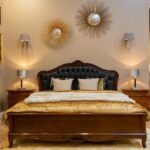Are you looking to transform your living space into a beautiful and functional haven? In this article, we will explore how to be a home decorator, from understanding the role of a home decorator to developing your personal design style. Interior design plays a crucial role in shaping the atmosphere and functionality of a home, and as a home decorator, you have the opportunity to bring your creative vision to life.
As we delve into the world of home decorating, we’ll discuss the different paths you can take to become a professional in this field. Whether it’s through formal education, certification programs, or hands-on training, there are various options available for those who are passionate about creating stylish and inviting spaces. Additionally, we’ll provide tips on uncovering and refining your unique design aesthetic, guiding you towards developing a personal style that reflects your personality and preferences.
Furthermore, we will explore the psychology of color and how it can influence the mood and ambiance within a home. Understanding color theory is essential for creating harmonious and visually appealing interiors. We’ll also offer practical advice on space planning and furniture arrangement to help you maximize both function and style within your living spaces. Join us as we embark on this journey to discover the art of home decorating.
Education and Training
For those who may not have the time or resources to commit to a formal degree program, certification programs are another option for aspiring home decorators. These programs are often shorter in duration and focus specifically on interior decorating techniques and principles. While they may not provide the same depth of knowledge as a degree program, certification courses can be a valuable way to gain practical skills and industry-recognized credentials.
On-the-job training is also a common route for individuals interested in pursuing a career in home decorating. Many decorators start off working under experienced professionals to gain hands-on experience and learn the ins and outs of the industry. This approach allows individuals to build their skills while establishing professional connections within the field. Additionally, taking on internships or apprenticeships with established interior designers can provide valuable real-world experience and mentorship opportunities.
Ultimately, the path to becoming a successful home decorator will vary depending on individual circumstances and career goals. Whether through formal education, certification programs, or on-the-job training, gaining knowledge and practical experience is key to succeeding in this creative and dynamic profession.
Developing a Personal Style
Experimenting with different design elements can also help in developing your personal style. Try incorporating various colors, patterns, and furniture styles into your own living space to see what feels most authentic to you. It’s important not to rush this process as developing a personal style takes time and should be an ongoing journey of self-discovery.
Another helpful tip is to take note of designs that evoke an emotional response from you. Whether it’s a sense of calmness, happiness, or excitement – recognizing what makes you feel certain emotions within a space can provide insight into your unique design aesthetic. Ultimately, don’t be afraid to trust your intuition and let your personal style shine through in your work as a home decorator.
| Personal Style Tips | Advice |
|---|---|
| Draw Inspiration | From various sources such as interior design magazines, websites, social media platforms. |
| Experiment | Incorporate different colors, patterns, and furniture styles into your living space. |
| Recognize Emotions | Note designs that evoke emotional responses – calmness, happiness or excitement. |
Understanding Color Theory
Color plays a crucial role in home decorating as it has the power to evoke different emotions and create various moods within a space. The understanding of color theory is an essential skill for home decorators who wish to transform a house into a beautiful and inviting home. By exploring the psychology of color, decorators can strategically use different hues to achieve the desired atmosphere in each room.
The Psychology of Color
Each color has its own psychological effects on individuals. For example, warm colors like red, orange, and yellow are known to energize and create a sense of coziness, while cool colors such as blue and green have a calming effect and can make a space appear more spacious. Understanding these associations can help home decorators in choosing the right colors for different rooms based on their intended purposes.
Using Color to Create Different Moods
Home decorators can use their knowledge of color theory to create specific moods or atmospheres within a home. For instance, vibrant and bold colors can infuse energy into a room, making it ideal for social gatherings or entertaining. On the other hand, soft and soothing shades can promote relaxation, making them perfect choices for bedrooms or reading nooks.
Harmonizing Color Schemes
Incorporating multiple colors into a room requires careful consideration of how they work together. Home decorators should explore various color schemes such as monochromatic, complementary, or analogous options to find the perfect balance that suits their design goals. With this knowledge, they can create harmonious interiors that are visually appealing and cohesive. Understanding color theory empowers home decorators with the ability to transform any living space into an inviting and aesthetically pleasing environment through strategic use of color.
Space Planning and Furniture Arrangement
When it comes to home decorating, effective space planning and furniture arrangement are crucial in creating a functional and stylish living space. Here are some key tips to consider when it comes to maximizing both function and style within a room:
- Assess the room: Before arranging any furniture, take the time to assess the size and shape of the room. Consider architectural features such as windows, doors, and built-in elements that may impact furniture placement.
- Determine the focal point: Every room should have a focal point, whether it’s a fireplace, a large window with a beautiful view, or a piece of artwork. Arrange your furniture around this focal point to create a cohesive layout.
- Create conversation areas: In larger rooms, it’s important to create distinct conversation areas by grouping furniture together. This can be achieved by using area rugs to define each space or arranging seating in a semi-circle formation.
- Traffic flow: Consider the flow of traffic within the room and ensure that there are clear pathways between furniture pieces. Avoid blocking natural walkways or door openings with large pieces of furniture.
By considering these key elements when planning your space and arranging furniture, you can create a well-designed and functional living area that reflects your personal style and enhances daily living.
Budgeting and Sourcing
When it comes to home decorating, it’s important to create a beautiful space without breaking the bank. One of the key aspects of being a successful home decorator is finding affordable yet stylish home decor items. There are many ways to achieve this, from shopping at budget-friendly stores to DIY-ing your own decor pieces. It’s all about being creative and resourceful in your approach.
Creating a budget for your home decorating project is essential. Before you even start shopping for decor items, take the time to assess how much you’re willing and able to spend. Consider all aspects of the project, including furniture, accessories, paint, and any other materials that may be needed.
Once you have a clear budget in mind, it’s important to stick to it. Avoid impulse buying and carefully consider each purchase to ensure that it aligns with both your personal style and your budget.
In addition to finding affordable decor items and creating a budget, sourcing plays a crucial role in successful home decorating. Knowing where to look for quality yet inexpensive pieces can make all the difference.
Whether it’s scouring thrift stores and garage sales or keeping an eye out for online sales and promotions, there are countless opportunities to find stylish decor items at reasonable prices. By being patient and persistent in your search, you can create a beautifully decorated home that doesn’t break the bank.
| Budgeting Tips | Sourcing Suggestions |
|---|---|
| Assess your finances before setting a budget | Thrift stores and garage sales |
| Avoid impulse buying | Online sales and promotions |
| Consider each purchase carefully | Discount stores or clearance sections |
Incorporating Trends
Staying up to date with the latest interior design trends can be an exciting way to keep your home decor fresh and modern. However, it’s important to incorporate these trends in a way that still reflects your personal style and won’t make your home look outdated in a few years. Here are some tips on how to do just that:
- Research and Understand Trends: Keep up with the latest interior design magazines, websites, and social media accounts to stay informed about current trends. Understanding the reasoning behind certain trends will help you make informed decisions about which ones to incorporate into your home.
- Select Timeless Pieces: When incorporating trendy elements into your home decor, focus on selecting timeless pieces that have a modern twist rather than going all-in on passing fads. This could include investing in furniture or accessories with clean lines and simple designs that won’t go out of style quickly.
- Use Trendy Colors in Small Doses: If there are trendy colors that appeal to you, consider using them in small doses such as throw pillows, artwork, or accent pieces. This allows you to add a pop of color without overwhelming the space or making it too difficult or costly to update when the trend passes.
By following these tips, you can incorporate the latest interior design trends into your home while still maintaining a timeless and personal aesthetic that will withstand the test of time. Remember that your home should ultimately reflect your unique personality and lifestyle, so don’t be afraid to put your own twist on current trends.
DIY Projects and Personal Touches
In conclusion, becoming a home decorator involves a deep understanding of interior design principles, as well as the ability to infuse personal style and creativity into every project. By exploring different educational paths and training opportunities, individuals can develop the skills needed to excel in this field. Whether it’s through formal education, certification programs, or hands-on experience, there are various ways to hone one’s abilities as a home decorator.
Understanding color theory and space planning is essential for creating a harmonious and functional living space. By mastering these concepts, decorators can effectively utilize color and layout to evoke specific moods and maximize the use of each room. Additionally, budgeting and sourcing play a significant role in home decorating, requiring decorators to find stylish decor items at affordable prices while adhering to a set budget.
Moreover, staying abreast of the latest interior design trends allows home decorators to incorporate fresh ideas into their work without dating their decor. Lastly, DIY projects and creative ways of displaying artwork and accessories offer decorators an opportunity to infuse homes with personal touches that reflect the unique tastes and preferences of their clients. Ultimately, by following these tips and guidelines, aspiring home decorators can create captivating living spaces that are both beautiful and functional.
Frequently Asked Questions
How Do I Start a Career in Home Decor?
Starting a career in home decor can be achieved in several ways. One common path is to pursue a degree or certification in interior design or a related field.
Another option is to gain experience through internships or entry-level positions at design firms, home decor stores, or furniture companies. Building a portfolio of your work and networking within the industry can also help jumpstart a career in home decor.
What Do You Need to Be a Decorator?
To become a decorator, you’ll need a combination of creativity, an eye for design, and strong interpersonal skills. Education in interior design or a related field can be beneficial, but it’s not always required.
Depending on your location, you may need to obtain certifications or licenses to practice as a decorator. It’s also important to have knowledge of color theory, textiles, space planning, and current design trends.
What Are the Qualifications of an Interior Decorator?
The qualifications of an interior decorator can vary depending on the specific job requirements and local regulations. Many decorators hold degrees in interior design, fine arts, or architecture, although it’s not always mandatory.
A strong portfolio showcasing your aesthetic style and design skills is often more important than formal qualifications. Some decorators choose to pursue professional certifications through organizations such as the American Society of Interior Designers (ASID) or the National Council for Interior Design Qualification (NCIDQ) to demonstrate their expertise and commitment to the industry.

I’m thrilled to be your companion on this exciting journey through the world of home decor and design. With a passion for turning houses into homes and a keen eye for the finer details, I’m here to help you transform your living spaces into beautiful, functional, and meaningful havens.





